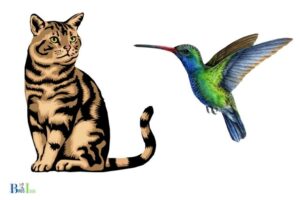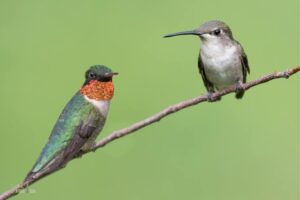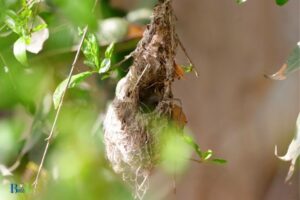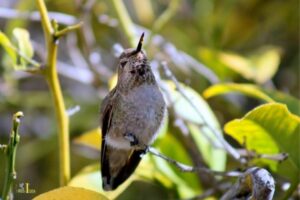How to Help a Hummingbird With a Broken Wing? 10 Steps!
To help a hummingbird with a broken wing, you should gently capture and handle the injured bird, assess the damage, provide supportive care, and seek professional help from a wildlife rehabilitator or veterinarian.
Hummingbirds can suffer from broken wings due to various reasons, such as accidents or predator attacks.
Since these delicate creatures rely heavily on their wings for survival, it’s crucial to give them proper care and treatment if you encounter one with an injured wing.
Gently capturing and handling the hummingbird is important to avoid causing further harm. Use a soft cloth or towel to pick up the bird, and be careful not to squeeze or apply excessive pressure to its body.
When assessing the damage, observe the broken wing and check for other injuries such as cuts or fractures.
To provide supportive care, place the hummingbird in a quiet and warm environment, preferably in a small box or container with ventilation, and offer a mixture of sugar water to help maintain hydration and energy levels.
Finally, it’s crucial to seek professional help from a licensed wildlife rehabilitator, a veterinarian, or a local animal rescue organization to provide appropriate treatment and care for the injured hummingbird.
10 Steps for Helping a Hummingbird With a Broken Wing
| Steps | Description |
|---|---|
| Step 1 | Observe the hummingbird and assess the situation |
| Step 2 | Prepare a container for the hummingbird |
| Step 3 | Gently capture the injured hummingbird |
| Step 4 | Place the hummingbird in the prepared container |
| Step 5 | Provide sugar water for the hummingbird |
| Step 6 | Keep the hummingbird in a quiet and safe location |
| Step 7 | Contact a local wildlife rehabilitation center |
| Step 8 | Follow the advice of the wildlife rehabilitation center |
| Step 9 | Safely transport the hummingbird to the rehabilitation center, if necessary |
| Step 10 | Allow experts to care for the injured hummingbird and release it when healed |
Key Takeaway
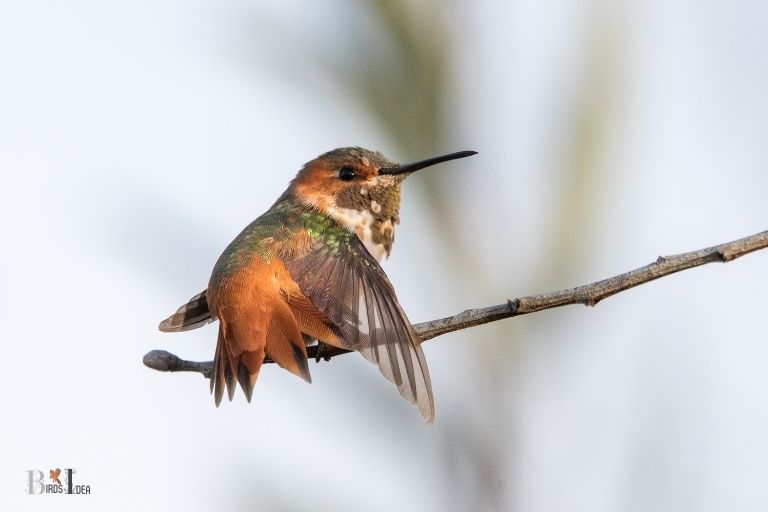
Five Facts About a Hummingbird With a Broken Wing
Understanding The Importance Of Helping A Hummingbird With A Broken Wing
Hummingbirds are fascinating creatures to observe, but sometimes, they can sustain injuries. One of the most common injuries among hummingbirds is a broken wing.
Unfortunately, this type of injury can prevent them from flying, making them vulnerable to predators, starvation, or dehydration.
Therefore, it’s essential to understand the importance of helping a hummingbird with a broken wing and to learn how to do so properly.
What Happens When A Hummingbird Injures Its Wing?
When a hummingbird injures its wing, it can no longer fly properly, which means it can’t perform its usual tasks such as searching for nectar, foraging for food, or escaping predators.
A hummingbird uses its wings for more than just flying, though; they also use their wings to regulate their body temperature, which is crucial to their survival.
In addition, the muscles of the wings help to power the hummingbird’s flight, so any damage to the wings can be life-threatening for the bird.
To make matters worse, hummingbirds are vulnerable to stress, and an injury can lead to stress that affects their immune system, causing them to get sick quickly. Therefore, it’s crucial to help a hummingbird with a broken wing as soon as possible.
Why Is It Necessary To Help A Hummingbird With A Broken Wing?
Helping a hummingbird with a broken wing is necessary because it can save their life. Hummingbirds are delicate creatures, and an injury as small as a broken wing can be fatal.
Here are some reasons why it’s necessary to help a hummingbird with a broken wing:
- A broken wing makes it difficult for the hummingbird to fly, find food, and escape predators.
- Hummingbirds need to maintain their body temperature, and a broken wing can cause them to become hypothermic or hyperthermic.
- Hummingbirds are vulnerable to stress, and an injury can lead to severe stress that can affect their immune system, leading to illness or death.
- When left untreated, a broken wing can become infected and can cause further complications, leading to the bird’s death.
Therefore, by helping a hummingbird with a broken wing, you are providing them with a chance to survive and recover from their injury. It’s a small act that can have a significant impact on the hummingbird’s life.
It’s crucial to understand the importance of helping a hummingbird with a broken wing. By doing so, you are providing them with a chance to survive and recover from their injury.
Remember to handle them with care, and if you’re unsure about how to help the bird, it’s best to contact a licensed wildlife rehabilitator.
Identifying A Hummingbird With A Broken Wing
Hummingbirds are fascinating creatures that capture our attention with their bright colors and nimble movements. Unfortunately, they are also susceptible to injuries that can hinder their ability to fly and survive in the wild.
One common injury is a broken wing, which can be difficult to observe without knowledge of the bird’s behavior and symptoms. In this section, we’ll discuss how to spot a hummingbird with a broken wing.
How To Spot A Hummingbird With A Broken Wing
Observing a hummingbird’s behavior and symptoms can help you identify if the bird has a broken wing.
Here are some key points to keep in mind:
- Look for a hummingbird that has difficulty flying or cannot fly at all.
- Notice if the bird often lands on the ground instead of perching on branches.
- Pay attention to the bird’s wing position when it is resting. A broken wing may droop or appear lower than the other wing.
- Observe if the bird appears to be in pain or is unable to move the affected wing.
If you notice any of these behaviors or symptoms, it is possible that the hummingbird has a broken wing and needs help.
How To Approach A Hummingbird With A Broken Wing
If you have identified a hummingbird with a broken wing, it is important to approach the bird with caution.
Here are some tips to consider:
- Wear gloves to protect yourself from the bird’s sharp beak and claws.
- Use a small towel or cloth to gently cover the bird and pick it up.
- Keep the bird in a warm, dark and quiet place with ventilation.
- Provide the bird with sugar water in a shallow dish or feeder.
Remember to contact a licensed wildlife rehabilitator for further advice and assistance.
By knowing how to spot a hummingbird with a broken wing and how to approach it safely, you can help provide the necessary care and attention to ensure its survival.
Making Necessary Preparations
To help a hummingbird with a broken wing, you will need to make certain preparations to ensure that you and the bird stay safe throughout the process. Here’s what you’ll need and how to create the right environment for the bird.
What You’ll Need To Help A Hummingbird
- Soft clean cloth or towel
- Shoebox or cardboard box with a lid
- Gloves
- Scissors
- Tweezers or forceps
- Keep sugar water ready
Creating The Right Environment For The Bird
Hummingbirds require a warm, dark, and quiet environment to reduce their stress levels during the recovery period.
Here’s how to create the right environment for the bird:
- Place the hummingbird in a small cardboard box or shoebox with a lid, lined with a soft and clean cloth or towel
- Keep the box in a safe and quiet place away from pets and children
- Ensure that the box is not exposed to direct sunlight or cool drafts
- Keep the hummingbird warm by placing a heating pad or hot water bottle under the box, making sure that the box does not become too hot
- Maintain humidity by spraying water on the cloth or towel regularly
- Keep a close eye on the bird, checking frequently for any changes or complications
- Keep sugar water ready for the bird to drink.
Ensuring Your Safety And The Safety Of The Bird
It’s essential to keep yourself and the bird safe while helping a hummingbird with a broken wing.
Follow these guidelines to ensure the safety of yourself and the bird:
- Wear gloves throughout the process to protect yourself from any diseases the bird might carry
- Handle the bird with extreme care, using tweezers or forceps to avoid injuring the bird any further
- Do not attempt to feed the bird unless instructed by a wildlife rehabilitator
- Contact a wildlife rehabilitator as soon as possible when you find a hummingbird with an injured wing.
Remember, it’s important to always contact a wildlife rehabilitator or bird rescue organization when you find an injured bird. They have the necessary knowledge and expertise to care for the bird and ensure its safe recovery.
By making necessary preparations, creating the right environment, and following safety guidelines, you can help a hummingbird with a broken wing and give it a chance to fly again.
Capturing And Restraining The Bird
Hummingbirds are lovely animals that can brighten up anyone’s day with their vibrant feathers and rapid wing flapping like fluttering jewels in the sky.
These birds are tiny and agile, making it challenging to capture and restrain them without causing harm.
If you stumble upon an injured hummingbird, you might feel the urge to help it. Here’s how to safely capture and restrain a hummingbird and make sure it stays calm and stress-free throughout the process.
How To Safely Capture A Hummingbird
Hummingbirds are fragile creatures, and any sudden movements can make them more anxious and fearful.
Follow these tips to capture them safely:
- Use a towel or cloth to cover the bird carefully. Do not make any sudden movements.
- Place the towel over the bird and gently wrap it.
- Scoop the bird into a small box or container. Make sure the container has tiny holes for airflow.
- Do not handle the bird too much, as this can cause further stress.
Techniques For Restraining The Bird During Handling
Once you have captured the hummingbird, you need to restrain it to prevent it from injuring itself or escaping.
Here are some useful techniques for doing so:
- Hold the bird gently but firmly with your fingers around its body, making sure you do not press too tightly.
- Make a fist around the bird’s body and use your thumb to hold the wings down, ensuring it cannot fly away.
- Use a small piece of tape to secure the bird’s beak, so it cannot bite you while handling.
- Be cautious while restraining the bird, as too much force can hurt it further.
Keeping The Bird Calm And Stress-Free
Hummingbirds are easily startled, and they can experience severe stress when they sense danger.
Follow these tips to ensure the bird remains calm and stress-free.
- Keep the bird in a quiet and dimly lit room to help it calm down.
- Make sure the bird is warm and comfortable by placing a warm, soft cloth in the container.
- Avoid making any sudden movements around the bird, as it may cause it to panic.
- Refrain from touching the bird too much, as this can cause discomfort and stress.
Rescuing a hummingbird in distress requires patience and gentle handling. If you follow these tips and take appropriate care, you can help rehabilitate an injured hummingbird and ensure its speedy recovery.
Remember, when releasing the bird, it should be done in the same location or close by since the bird knows its territory, and it will recognize familiar landmarks.
Providing First Aid
Hummingbirds are one of nature’s most fascinating creatures with their vibrant colors and unique abilities.
However, sometimes accidents happen, and we may come across a hummingbird with a broken wing. In such cases, it is important to provide immediate first aid to help the bird heal and recover.
Steps To Follow For Treating The Broken Wing:
- First, gently catch the hummingbird in a soft cloth, taking care not to cause further injury.
- Place the hummingbird in a shoebox with a soft cloth lining.
- Keep the box in a warm and dark place, away from other animals or children.
- Ensure that the box has enough ventilation so that the hummingbird can breathe.
- If the hummingbird’s wing is visibly broken, it is essential to apply a splint to help immobilize the wing while it heals.
Applying A Splint:
- Use a thin, light-gauge wire, roughly the size of a paper clip, to create a splint.
- Cut the wire so that it is roughly the same length as the hummingbird’s body.
- Bend the wire so that it gently wraps around the broken wing.
- Cover the wire with medical tape and ensure that it is securely attached to the wing.
Administering Pain Relief Medication:
- After consulting with a veterinarian or an expert, administering pain relief medicine can help reduce the hummingbird’s discomfort.
- Only use medication that has been approved for birds and with recommended dosages.
Stopping Any Bleeding If Present:
- Use a clean cloth or cotton ball to gently stop any bleeding from the broken wing.
- Be careful not to apply too much pressure or irritate the injury further.
- If the bleeding continues for a prolonged period, seek veterinarian attention immediately.
Helping a hummingbird with a broken wing requires patience and care. Remember to keep the bird in a dark and warm environment, apply a splint to the broken wing, administer pain relief medication if necessary, and stop any bleeding that may be present.
With these steps, we can provide the necessary first aid to help the hummingbird recover and fly once again.
Setting Up A Home Care Unit
Hummingbirds are fascinating creatures that often leave us in awe with their beauty and agility.
However, if you come across a hummingbird with a broken wing, it’s crucial to take immediate steps to provide it with the necessary care and attention.
In this section, we will guide you through the steps for setting up a home care unit for the bird.
Creating A Suitable Habitat For The Bird
Creating a suitable habitat for the hummingbird is the first step towards ensuring its recovery.
Here are a few things that you need to consider:
- Choose a spacious box with adequate ventilation. The box should be free from any sharp edges or rough surfaces that may harm the bird.
- Cover the bottom of the box with a soft cloth or tissue paper and place a branch in the box to provide a perch for the bird.
- Make sure that the box is placed in a warm and quiet area of your home, away from direct sunlight and any pets.
- Keep checking the box regularly to make sure that the bird is comfortable and safe.
Providing Adequate Food And Water
Hummingbirds have high metabolic rates and require a high sugar diet to survive.
Here are some things that you can do to keep the bird nourished:
- Prepare a sugar solution by mixing four parts of water with one part of white granulated sugar. Boil the mixture for a few minutes and let it cool down. Fill a small feeder with the solution and hang it in the box.
- Make sure that the hummingbird is drinking water regularly. A small water dish with clean water can be placed near the bird’s perch. You can also mist the bird with water to keep it hydrated.
- Keep a check on the feeder and water dish. Change the sugar solution every two to three hours and refill the water dish frequently.
Maintaining Proper Hygiene
Maintaining proper hygiene is crucial to ensure that the hummingbird does not get sick.
Here are some things that you should keep in mind:
- Clean the feeding dish and water dish regularly with warm water and soap.
- Change the soft cloth or tissue paper in the box regularly.
- Wear gloves while handling the bird to minimize the risk of infection.
- If you notice any signs of sickness such as lethargy or discharge from the beak, seek professional help immediately.
By following these steps and providing the necessary care and attention, you can help a hummingbird with a broken wing on its way to recovery. Remember, it requires patience and dedication, but the end result will be rewarding.
Monitoring The Bird’S Recovery
Tracking The Bird’S Progress
After helping a hummingbird with a broken wing, monitoring its recovery is essential for its survival.
Here are some tracking tips to ensure its well-being:
- Observe the bird: Keep an eye on the injured bird by noting its movements, how it drinks, eats and flies. This will help you determine its progress and how long it needs to fully recover.
- Keep a journal: Record observations, any changes or improvements in the bird’s behavior, and any medication or treatment given. It will help you understand the bird’s recovery cycle and identify the progress made.
- Take photos: Taking pictures is an effective way to identify the bird and its progress. You can compare the photos over time to check for changes, such as feather growth, color, and overall appearance.
Recognizing Signs Of Improvement
A crucial part of helping a hummingbird with a broken wing is recognizing signs of improvement.
Here are some indications that the bird is making progress:
- Stable movement: If the bird begins to move more smoothly, it can be a sign of a healed wing.
- Improved flight: Once healed, the bird’s wing should begin to work correctly. Observe whether it begins to fly and hover for a more extended period.
- Energy levels: A happy and healthy hummingbird will have high energy levels and enjoyable chirping sounds to indicate that it is on the road to recovery.
Dealing With Setbacks
While tracking the hummingbird’s progress and recognizing improvement are essential, setbacks can happen anytime.
To manage such setbacks, keep the following tips in mind:
- Seek professional advice: If you are worried about the bird’s recovery, see a professional bird specialist for advice on treatment, medication, and other ways to help the bird heal.
- Do not panic: Do not panic if the bird regresses. Continue with your monitoring and treatment while staying positive for the bird.
- Adjust recovery plan: If setbacks continue, it may be time to adjust your bird’s recovery plan. That can include changing diet, giving different medications or adjusting the bird’s environment.
By tracking the hummingbird’s progress, recognizing signs of improvement, and dealing with setbacks, you can provide the necessary care and support to help the bird recover successfully.
Preparing For Release
Determining If The Bird Is Fit For Release
Before releasing a hummingbird, it is crucial to determine if the bird is ready and capable of surviving in the wild.
Here are some key points to consider:
- Observe the bird: Watch the bird carefully for a few days to ensure it can fly without any problems. Observe its feeding habits and make sure it is eating properly.
- Assess the bird’s strength: Check to see if the bird is able to perch on a branch steadily. If the bird is unable to do so, it may not be ready for release.
- Check for any signs of remaining injuries: Observe the bird for any signs of injury or weakness, such as difficulty flying or irregular breathing. If there are any signs of lingering health issues, it may not be time to release the bird.
Release Location And Timing Considerations
Choosing the right location for release is essential for the hummingbird’s survival.
Here are some key considerations to keep in mind:
- Choose a safe area: Release the bird in a location that is safe and away from predators. Hummingbirds need plenty of space to fly, so an open area with plenty of flowers and nectar sources is ideal.
- Have patience: Don’t rush the release process. Give the bird time to adjust to its surroundings and familiarise itself with the new area. Once it is ready to fly, it will take off on its own.
- Consider the weather: Release the bird when the weather is mild and favourable. If the weather is too hot or too cold, it may negatively impact the bird’s chances of survival.
Releasing The Bird Back Into The Wild
The following steps will help ensure that the hummingbird is successfully released back into the wild:
- Choose a good time of day: It’s best to release the bird in the early morning or late afternoon when it is less likely to encounter predators.
- Open the carrier: Gently open the carrier and let the bird fly out on its own. Don’t touch or force the bird to leave.
- Monitor the bird: Watch the bird for a while to ensure it can fly without any issues. Check to see if it is eating and foraging for food correctly.
By following these guidelines, you can help ensure that the hummingbird has the best possible chance of survival after its release back into the wild.
Post-Release Care
Observing The Bird After Release
It takes a lot of effort, patience, and dedication to help a hummingbird with a broken wing. But the real task begins when you release the bird back into the wild. Y
ou must observe the hummingbird carefully after release to ensure it’s safe and adjusting to its new environment.
Here are some crucial points to remember:
- Monitor the bird for at least 30 minutes post-release to ensure it has flown away safely.
- Keep a check on the surrounding area for predators or other potential dangers.
- If you spot the bird struggling to fly or in danger, take immediate action to ensure its safety.
Continued Care And Monitoring
The care for a hummingbird with a broken wing doesn’t end when you release it. You must provide additional care and monitoring to the bird to ensure its full recovery and survival in the wild.
Here are some points to remember:
- Provide enough food resources around the bird feeder to ensure the bird gets proper nutrition.
- Keep the feeder clean and well-stocked to prevent the bird from being exposed to harmful bacteria.
- Monitor the bird feeder regularly to keep a check on the status of the recovering hummingbird.
Reporting Your Success Story
Reporting your success story can help inspire others to take up the noble task of helping an injured hummingbird.
Here are some suggestions for reporting your story:
- Share your story on social media or hummingbird support groups to encourage others to take action.
- Use hashtags and relevant keywords to reach a wider audience and attract more attention to your cause.
- Share photos and videos of your journey with the bird, which can grab the attention of potential supporters.
Remember, a small gesture from your side can give a second chance at life to a hummingbird with a broken wing. Your effort can make all the difference!
FAQ On Hummingbird With a Broken Wing
How Do I Know If A Hummingbird Has A Broken Wing?
What Should I Do If I Find A Hummingbird With A Broken Wing?
Can I Attempt To Heal A Hummingbird’s Wing On My Own?
How Do I Find A Licensed Wildlife Rehabilitator In My Area?
How Can I Prevent Hummingbird Injuries In My Yard?
Conclusion
It’s heartbreaking to see a hummingbird with a broken wing, but there are things you can do to help. The first thing is to keep the bird safe and away from predators. You can also provide it with food and water while it recovers.
If you’re able to, you can take it to a licensed wildlife rehabilitator who will know the best way to help it heal. It’s important to remember that these birds are delicate and handling them can cause more harm than good.
By taking care of a hummingbird with a broken wing, you’re not only helping one bird, but also contributing to the preservation of these beautiful creatures. These birds play an important role in pollination, making them a vital part of our ecosystem. We can all do our part to help protect them.

